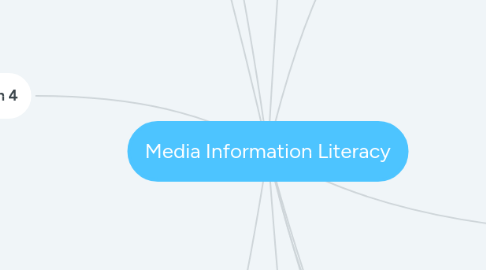
1. Photography and Timeless Image Concepts
2. Lesson 3: Understanding Media: Aesthetics of the Image Text and Audio
2.1. Framing and Reading
2.1.1. Create with a solid plan to follow using a specific structure in mind
2.2. Newspapers and Journalism
2.2.1. Most evident in the world of news
2.2.2. Information on current events
2.3. Books, Comics, Magazines, and the Publishing Industry
2.3.1. Printed Books
2.4. Radio and Evoking Imagination
2.4.1. Reach a wide array of areas
2.4.2. Most popular form of mass media allover the world
2.5. Framing and Listening
2.5.1. Imagination
3. Lesson 4
3.1. Film Form
3.1.1. moving pictures
3.1.2. Celluloid film strip
3.2. Modes of Film Production
3.2.1. preproduction
3.2.2. production stage
3.2.3. postproduction stage
3.3. Film Formats
3.3.1. Narrative
3.3.1.1. Characters and situations were made up by the film's scriptwriter
3.3.2. Documentary
3.3.2.1. opposite of narrative fiction film
3.3.2.2. made to present a specific issue
3.3.3. Animation
3.3.3.1. Moving non-human things
3.3.4. Experimental
3.3.4.1. tries to play around with the physicality
3.4. Film Image Composition
3.4.1. Film Language
3.5. Motion Framing Concepts
3.5.1. Movement is important
3.6. TV Broadcast
3.6.1. Has more stable and unending supply of content
3.7. Kinds of TV Shows
3.7.1. Informative Programming
3.7.2. Entertainment Programming
3.8. TV Show Anatomy and Advertising
3.8.1. Commercial gap or commercial break
3.9. Crafting Media Messages
3.10. Creating Meaning in Audio Production
3.10.1. Composed of sounds, music, noise, or dialogue
3.11. Creating Meaning in Image Production
3.11.1. Generally visual-minded
3.12. Creating Meaning in Audiovisual Production
3.12.1. Audio Hook
4. Lesson 5: Understanding Media: Aesthetics of New Media
4.1. Deconstructing New Media
4.1.1. Web-based Applications
4.2. New Media Technology: Convergence and Characteristics
4.2.1. To produce better quality media content
4.2.2. easier to duplicate and distribute
4.3. New Media as Multimedia
4.3.1. A single media product could contain several forms of media content
4.4. New Media Transitions: from Synergy to Transmedia
4.4.1. Synergy pertains to maximizing the economic opportunities within its conglomerate
4.5. Journalism+ Internet=Blogging
4.5.1. weblog
4.5.2. Intersecting Traditional Media and New Media
4.5.2.1. HyperText Markup Language (HTML)
4.5.2.2. Uniform Resource Locator (URL)
4.6. Broadcasting+Internet=Podcast
4.6.1. audio and video media files that are released periodically
4.7. Film+Internet=Youtube
4.7.1. Youtube or vimeo
4.8. Transitioning Media, Transitioning Users
4.8.1. Digital native and digital immigrant
5. Social Networking
6. Culture of Entertainment
6.1. Pop Culture
6.1.1. mass-produced or mass-oriented
7. Print Industry and Filipino Freedom
7.1. Del Superior Govierno
7.2. La Solidaridad
7.3. European File Import
7.4. Broadcast Industry
7.5. Local Online Media
8. Pre-Colonial Traces
8.1. Alibata or baybayin
8.2. Umalohokan
9. Lesson 1: What is Media?
9.1. Communication Process
9.1.1. Shannon - Weaver Model of Communication
9.1.1.1. Sender
9.1.1.2. Message
9.1.1.3. Channels
9.1.1.4. Receiver
9.1.2. Feedback Mechanism
9.2. Information Industry
9.2.1. Film Industry
9.2.2. Broadcast Industry
9.2.3. Publishing Industry
9.2.4. Photography Industry
9.3. Kinds of Media
9.3.1. Traditional
9.3.1.1. Print Media
9.3.1.1.1. Newspaper
9.3.1.1.2. Magazine
9.3.1.1.3. Comics
9.3.1.1.4. Books
9.3.1.2. Broadcast Media
9.3.1.3. Film or cinema
9.3.2. New
9.3.3. Social
9.4. Mobile Communication Technology
9.5. Related and Emerging Technologies
10. Lesson 2
10.1. Pre-industrial Age
10.1.1. Oral traditions
10.2. Industrial Age
10.2.1. Evolution of factories
10.2.2. Assembly line work flows
10.2.3. Devising Mechanisms
10.3. Electronic Age
10.3.1. Technological developments of the industrial age heavily utilized electricity
10.4. Digital Age
10.4.1. Current age
10.5. Brief History of Philippine Media
11. Lesson 6: Understanding Media: Aesthetics of Social Networking
11.1. Deeper Understanding of Social Media
11.2. Kinds of Social Media and it's varying uses
11.2.1. Print-based
11.2.2. Audio-based
11.2.3. Photo-based
11.2.4. Video-based
11.2.5. Social Networking Sites
11.3. Relevance of Social Media in Today's Society
11.3.1. Directly engage with their constituents
11.4. Personal Communications
11.5. Business and Customer Care Tools
11.5.1. Brand companies, also fin social networking sites and apps useful in the line of their work
11.5.2. Useful for people who communicate with their loved ones
11.6. Social Services and Governance
11.6.1. Governments use social networking sites.
11.7. Educational Tools
11.7.1. e-books
11.7.2. blogging
11.8. Traditional Media Coverage and Social Media Enhancement
11.8.1. Immediate and elaborate feedback coursed through social media channels
11.9. Entertainment Portals
11.9.1. pop culture content curating
